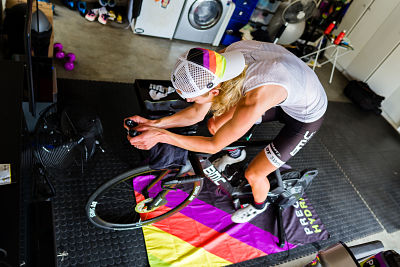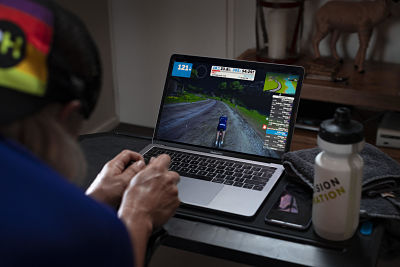Long before Covid-19 drove us into our garages, indoor training was already a thing as far as sport and cycling goes. In fact, you could go all the way back to 1884 and find an indoor trainer for a Penny Farthing if you were so inclined to turn the cranks whilst wearing a top hat. Mind you, the reality is that many of us probably didn’t discover indoor training until at least the 1990’s.
Back in those days, early commercial turbo trainers were becoming incredibly popular and I bought my first one around late 2002 when I was starting out in triathlon. I remember the date specifically because I’d recently moved into a new house that I’d lovingly redecorated, only to then ruin my shades of ‘evening sunset’ paint when my turbo disintegrated my rear tyre due to the heat build-up and then sprayed the tyre’s debris up the walls.
There are a range of products, apps and add-ons to bring the outside in and for many, to provide the structure and benefits that indoor cycling can deliver. However, there are subtle differences between them. It’s often about marrying the technology to what you prefer and what your goals may require...
Why train indoors?
It’s pretty much universally understood that cycling is going to be beneficial to you whether you do it inside or out. The key advantages with indoor cycling are that you’re avoiding traffic, junctions, stopping and coasting, meaning you’ll probably get a different rate of work done.
There’s often talk of how many hours of training indoors are worth that of outdoors. In my experience, I’d merely look at the power data and see what kilojoules were expended or what training stress score had been accumulated and then compare that to outside. In general, I do around 20% more for the same duration. To be honest though, I ignore any such comparisons and merely do what my training plan asks for. If I’m down to do a four-hour ride, I do four hours irrespective of where it is.

However, something else to be aware of is that a recent study illustrated that your performance inside will likely differ to what you’ll achieve outside. Chances are that your power output inside will be lower for the same effort that you’d apply outside. The reasons for this are differences in equipment, the human body’s difficulty in dealing with the heat, or merely the difference in pedalling inertia or muscle recruitment when you’re sat on the turbo compared to gliding along outside. I personally believe there’s nothing wrong with this, provided you don’t exclusively do indoor training and then immediately try and race outside.
At the very least, allow some weeks prior to your big race to acclimatise back to outdoor riding and to ensure you polish up your bike handling.
An introduction to indoor trainers
As you’d expect, trainers vary in features, quality and cost. Essentially, the need for this equipment is to measure your power output, transmit this to the e-cycling app and then use that information to control the rider’s avatar. Fundamentally speaking, there are five main types of static trainers.
The most expensive and specialised are known as ‘smart bikes’. These resemble a conventional gym exercise bike rather than require use of an actual bicycle. The advantages of these are they are more stable due to having a good sized footprint and being heavier in weight as well as being clean and a neater set up to deal with.
The second are known as ‘Smart’ trainers. These allow for a conventional bicycle to be fitted but with its rear wheel removed. This is also known as a ‘direct drive’ trainer. The e-cycling app can then send information to the smart trainer to provide resistance to the cyclist based on what virtual terrain they are currently cycling over in terms of gradients and surfaces but because it’s a conventional bike, you can pack it all down easily.
Thirdly, there are static trainers that are known as ‘wheel on’. These require the full bicycle to be mounted into it but the rear wheel makes contact with a roller whose resistance is then controlled by the computer. There’s less faffing with taking wheels on and off and they are typically cheaper but you can get some wheel slippage if you put in a big sprint effort.
The most affordable option though are known as ‘dumb’ trainers. These are essentially the turbo trainers many of us grew up with. In these cases, the trainer doesn’t provide resistance to the cyclist or record power unless the rider has a power meter fitted.
Finally, there are the rarer ‘smart rollers’ which are like the rollers that track cyclists often use but these too are controlled by the app. These provide a realistic riding experience as the rider isn’t attached at all but require some skill, balance and practise to be competent on them. I learned to ride rollers inside my lounge doorframe once whilst watching a comedy on TV. I then laughed, slipped off the side of the rollers and then tore across my carpet crashing into my sofa still attached to my bike. The effort required on rollers makes the time fly fast but it’s embarrassing trying to explain the tyre tracks on my carpet to guests.
Which app should you use?
As far as apps go, like the trainers themselves, you’ve got a lot of choice. Most will be familiar with arguably the biggest, Zwift, but there are also others like Wahoo RGT, Rouvy, TrainerRoad, and BKool, whilst for runners who prefer the treadmill there are running specific apps like Kinni which provides a library of workouts. Most require some level of paid subscription and they all offer a slightly different experience to each other.

The key characteristic here is whether the rider emphasises cycling simulation or what is known as ‘gamification’. Gamification is ‘the use of game design elements but applied within a non-game context’ – in this case cycling.
A recent review revealed that some level of gamification is useful in sports apps because it provides users with motivation, helps generate self-confidence and ultimately provides the means for participants to benchmark their abilities against others. I also believe that by providing these opportunities in a relatively anonymous setting provides a non-judgemental environment that many will prefer. If you ever see someone struggling in a D-category online race and they’re called ‘Poppy Flophandles’ or ‘Bittybean Bobblebum’, it’s probably me trying to hide the shame of it all.
Zwift offers a large level of gamification with features such as power-ups or levels that unlock certain features as you would see with a console game. This is designed to keep you motivated and engaged with your virtual experience.
Alternatively, Rouvy actually overlay a digital avatar onto real footage as an augmented reality-style experience. These are all different. The number of races and training sessions also vary massively between them.
Zwift is the most popular by far but, in my experience, it can also be rife with riders cheating. The question here is what you value the most in terms of features and feel. Most offer some level of free trial and its worth giving a few a go to find out which suits you.
Other tech to consider
If you want to enhance your indoor riding experience, you’ll also want to think about some other things you might want.
The first are cooling strategies. Nutrition and fluid intake is essential but the absence of air flow normally caused by the riders moving through the air is going to heat you up pretty fast. The use of fans can really help keep this under control. My training room sounds like the final game of the ‘Crystal Maze’ TV show that was popular in the UK circa 1990 (anyone under the age of 40 probably will need to look that one up).
Likewise, specific clothing is starting to spring up that is designed for the indoor cycling environment. Shoe companies, including Shimano, Nike and Adidas, are marketing specific footwear for the purpose, whilst clothing companies like Nopinz are producing clothing that can hold ice packs to help keep you cool indoors.
Finally, if you’re not using a smart bike or smart trainer, you might want to factor in the cost of a power meter too, so that your wattage can be transmitted to the app externally. This isn’t always essential though as some apps can apply their own algorithms to estimate the power output of the rider based upon the rear wheel speed rotating, but this can be woefully inaccurate and not ideal if you’re doing specific training intervals. I’ll actually cover this sort of thing in more detail at some point when I explain how you can weaponise both you and your set-up to maximise your on-screen performance.
All in all, indoor training isn’t the mind-numbing, short, staring at the wall experience it was a decade ago. It can be a fun diversion from outdoor riding, help keep your motivation up when the weather is poor, or if you simply fancy engaging with a large global community.
